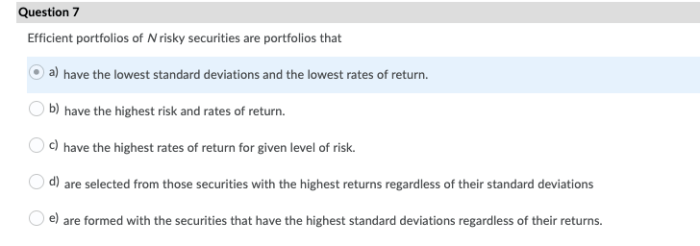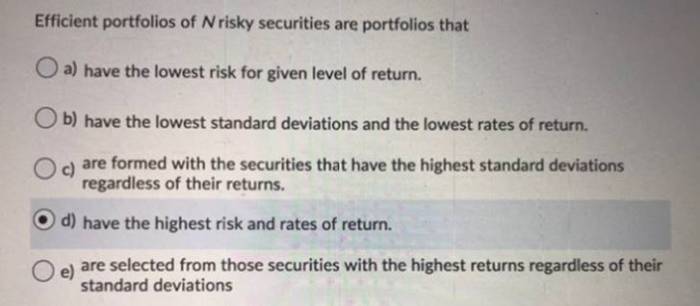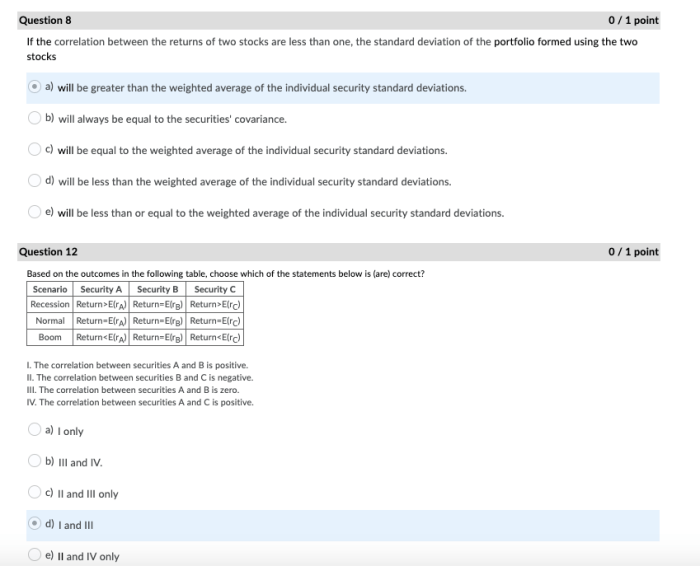Efficient portfolios of n risky securities are portfolios that offer the highest possible return for a given level of risk. These portfolios are constructed using various methods, including mean-variance optimization, and can be tailored to meet the specific risk tolerance and investment objectives of individual investors.
This article provides a comprehensive overview of efficient portfolios, including their characteristics, methods of construction, and the role of risk and return analysis, diversification, and asset allocation in their management.
Definition and Overview

Efficient portfolios, a cornerstone of modern portfolio theory, represent the optimal combination of risky securities that maximize expected return for a given level of risk.
In the context of “n risky securities,” n refers to the number of individual assets included in the portfolio. These securities could be stocks, bonds, commodities, or any other investment vehicle with inherent risk.
Characteristics of Efficient Portfolios: Efficient Portfolios Of N Risky Securities Are Portfolios That

Efficient portfolios are characterized by several key features:
- Maximum Expected Return:They provide the highest possible expected return for a given level of risk.
- Minimum Risk:They minimize risk while maintaining a desired level of expected return.
- Diversification:They include a mix of assets with different risk and return profiles, reducing overall portfolio risk.
- Correlation:They consider the correlation among securities, ensuring that the portfolio is not overly concentrated in any one asset class.
Methods for Constructing Efficient Portfolios
Various methods are used to construct efficient portfolios, including:
- Mean-Variance Optimization:This mathematical technique optimizes portfolio weights to achieve the highest expected return for a given level of variance (risk).
- Risk-Return Analysis:This involves plotting the expected return and risk of different portfolio combinations to identify the efficient frontier.
- Monte Carlo Simulation:This stochastic method simulates portfolio performance under various scenarios to estimate risk and return.
Risk and Return Analysis

Efficient portfolios navigate the trade-off between risk and return:
- Higher Expected Return:Comes with higher risk, as investors seek compensation for taking on additional uncertainty.
- Lower Expected Return:Offers lower risk, as investors prioritize capital preservation over potential gains.
Investors can optimize their portfolios based on their risk tolerance and investment goals.
Diversification and Correlation

Diversification is crucial in reducing risk in efficient portfolios:
- Uncorrelated Assets:Diversifying across assets with low correlation helps mitigate overall portfolio risk.
- Correlation Impact:Positive correlation amplifies portfolio risk, while negative correlation reduces it.
Understanding correlation is essential for constructing well-diversified portfolios.
Asset Allocation
Asset allocation involves determining the proportion of each asset class in an efficient portfolio:
- Risk Tolerance:Allocation should align with the investor’s risk tolerance and time horizon.
- Investment Objectives:Goals, such as capital growth or income generation, influence asset allocation.
- Rebalancing:Periodically adjusting asset allocation ensures the portfolio remains aligned with investment objectives.
Rebalancing and Monitoring
Rebalancing and monitoring are crucial for efficient portfolios:
- Rebalancing:Periodically redistributing assets to maintain desired portfolio weights and risk levels.
- Monitoring:Tracking portfolio performance, economic conditions, and market trends to make informed adjustments.
- Performance Evaluation:Assessing portfolio returns against benchmarks and adjusting strategies as needed.
Ongoing monitoring and rebalancing ensure efficient portfolios continue to meet investor goals.
FAQ Resource
What are the key characteristics of efficient portfolios?
Efficient portfolios are characterized by their ability to maximize return for a given level of risk, or minimize risk for a given level of return.
How are efficient portfolios constructed?
Efficient portfolios can be constructed using various methods, including mean-variance optimization, which involves finding the optimal combination of assets that minimizes the portfolio’s variance (risk) for a given expected return.
What is the role of diversification in efficient portfolios?
Diversification is a key strategy in efficient portfolio construction, as it helps reduce risk by investing in a variety of assets with different risk and return characteristics.